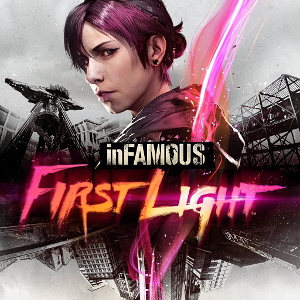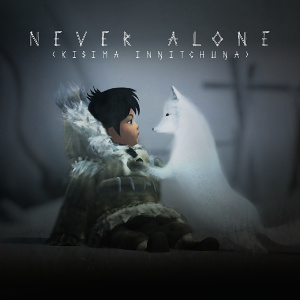
I have a new short story at Lackington’s, as part of their beldam issue. It’s based around English river hag folklore, with a side helping of cosmic knowledge and imaginary time.
Story Link: After the Rain
Of speculative fiction, reviews and random tangents

I have a new short story at Lackington’s, as part of their beldam issue. It’s based around English river hag folklore, with a side helping of cosmic knowledge and imaginary time.
Story Link: After the Rain

Developer: Sucker Punch Productions
First Release: 27th August, 2014
Version Played: PS4
Length: Short
Links: Trailer One, Trailer Two
inFAMOUS: First Light is a short prequel to inFAMOUS: Second Son – a 3D action game set in the near future. First Light was offered as extra content for Second Son players, but is also sold as a standalone game. I got a copy as part of my PlayStation Plus subscription, having never played the other inFAMOUS games. My thoughts are from the perspective of how the game stands up on its own for players who are coming into the series with this as their first game.
In the inFAMOUS world, conduits (superpowered people) are controlled by the authorities in the USA. They’re locked up in government facilities and trained to use their powers for official purposes (like working for the D.U.P., who contain and control conduits).
Abigail “Fetch” Walker is a conduit who controls neon. When she’s a child, her parents want to turn her over to the authorities, so her older brother runs away with her. They spend years living on the streets, struggling with drug addiction, and carrying out petty theft to raise enough money to escape to Canada. This evidently goes wrong, as Fetch is in a D.U.P. prison for conduits, telling her story about what happened in Seattle a few years earlier.
It was clear the game wasn’t initially intended for people who hadn’t played Second Son. The early part forgot a few details, like highlighting what waypoints looked like. Or that waypoints existed at all, and that was the place I needed to go on the map. I wandered a series of streets I couldn’t tell apart until I figured it out. Once at the waypoint, it threw me into a combat situation without a clue about which keys were for combat. A button-mashing extravaganza ensued.
Once I survived that, the game had a combat tutorial (these take place in the prison, where Fetch alternates between telling her story and doing combat training). Because the best time for a combat tutorial is after you’ve already had to fight something. Needless to say, the game wasn’t making the best impression at this point.
But it was free and I wasn’t going to get any more free games for a few weeks, so I kept at it. I took some time out from missions once the open-world objectives appeared on the map. A bit of wandering around and fighting random gang members helped a lot with learning the combat system. The game grew on me after that point, though still had some issues.
Starting with the positives, I liked Fetch. Her neon powers are interesting (she absorbs neon, and uses it to create light weapons, turn into light and run, and other things). Her character design is good, with clothes and mannerisms that match her character, rather than having her posing sexily in her underwear (unfortunately common in games, even when it’s snowing). Her voice actress hits the mark of someone young who’s been through a lot.
The portrayal of women was generally okay. Of the main voice-acted parts, three are women (Fetch, the head of the prison, and a hacker who helps on some missions) and two are men (a drug lord and Fetch’s brother). So Fetch isn’t a single woman in a world consisting entirely of men. There are some uncomfortable themes, like the drug dealer being creepy and sexist towards Fetch, and women being kidnapped by human traffickers, but these aren’t shown as good things (or shown in such loving detail that it seems the storywriter is fetishising them). I would have liked to hear a female voice alternative for the D.U.P. armoured people, as it’s clear they employ women and anyone could be in those armour suits… yet the voice for the mob is always a man. Though the main point isn’t so much First Light, but that the main games of the series have all had men as leads. Fetch gets a smaller prequel game rather than a main title, which is an elephant that needs pointing out.
The open world (the Seattle parts of the game) was a good idea in principle, with collectibles (lumens), lumen races (chasing after moving lumens) and neon graffiti as things to find. It encourages the player to explore the whole map. It’s only a pity the city wasn’t worth exploring. Seattle was beautifully textured for sure. The rain effects were nice, like reflections in the puddles and rain falling on the camera when it was angled up. But the city districts weren’t very distinctive. The buildings felt like empty boxes, which were only there as platforms to jump off to reach lumens. There wasn’t a sense of exploration or finding something unexpected around the corner. A few buildings were clearly copies from the real Seattle, which is nice enough, but the overall city was rather lifeless. As most of the game took place here, this was a problem.
Story isn’t a strength of the game. It has a straight-forward and simple storyline. It does its job well enough, of introducing the character, and holding together the action. It’s just not likely to surprise anyone.
Once the game is done, the player can continue to roam Seattle or play in the prison arenas. The arenas score points, which go on a leader board. In theory, a player could spend a lot of time playing the arenas to compete with other PlayStation players. In practise, I doubt that many people keep playing the arenas after they earn their trophies, as they’re not that interesting. It is worth going for the trophies though, as unusually for a short game, this one comes with a platinum trophy.
I enjoyed the game in the end, but not enough to want to buy the other inFAMOUS games. I might have been swayed if Fetch had been the main character in Second Son, but she isn’t. As far as First Light goes, the grittier sides of the world might put off some players, as there is human trafficking, torture and needles are shown. But if you’re in the market for an action game where you get to smite things with superpowers, and you’re not too worried if the world and story aren’t the strongest, it’s not a bad title.

Developer: Upper One Games, E-Line Media
First Release: 18th November, 2014
Version Played: PS4
Length: Short
Links: Game Website
Never Alone (Kisima Ingitchuna) is a side-scrolling platform game, produced in collaboration with the Iñupiat (Alaska Native peoples). When endless blizzards stop her community from hunting, a young girl (Nuna) heads out into the storm to find the source. She’s soon joined by an arctic fox.
Most of the game mechanics will be familiar to players of this type of game. Nuna can move objects, climb ropes and throw a bola. Fox can scrabble up walls. The difference comes in how the mechanics fit into the game. Air currents used to help or hinder jumps aren’t uncommon, but here the gusts of wind are the ever-present blizzard at the centre of the narrative. Moving platforms are common in the genre, but these platforms are in the form of spirits, which Fox calls and can direct. They fit naturally into the game world, rather than seeming like something that wouldn’t be there if it wasn’t needed for the game.
The atmosphere and story of the game are its strong points. It successfully creates the feel of the tundra and beyond, and the artwork used for the spirits is lovely. The story is a re-telling of a traditional story, with additions and changes to expand it for the game. This is reinforced with narration in the Iñupiaq language and cut-scenes reminiscent of scrimshaw art.
The cultural insights are also a great feature. During the game, there are a number of owls. Reaching the owls unlocks a cultural insight, which can be watched at any point. These are mini documentaries with Alaska Native people talking about their lives and culture. The insights explain various aspects of the game, including how the story is different to the original story. There are also quotes from this story on loading screens. So without leaving the game, the player understands how the game story was constructed (a notable change is turning a man into a young girl and her fox), and the people and culture behind it.
There were some aspects of the game controls that were a bit clunky. In single player mode, it would be very useful to be able to tell the other character to stay. For some puzzles, the AI would walk them into dangerous places (they wouldn’t jump to their death or anything, but would stand in the path of moving dangers). It wasn’t game breaking, as the AI could be dealt with by leaving the other character in a different place. But this could be smoothed out in future releases from the developer.
Experienced gamers will likely find the gameplay on the easy side. However, the atmosphere and the cultural insights made it stand out. I loved exploring the world as Nuna and Fox, and would be on board for any of their future adventures.

My story “Never the Same” is up at Strange Horizons. It’s a science fiction mystery. I wrote it about the time I started my cozy mystery novel, so it’s a play on some of those tropes… but in a less cozy way.
Also has birds and terraforming!
 First Published: 1st September, 2013
First Published: 1st September, 2013
Genre: Speculative Fiction / Short Story Collection
Available: Amazon.com | Amazon UK
Silvia Moreno-Garcia’s collection has stories mostly set in Mexico, with speculative and folkloric themes. My favourite was “Maquech”, about selling live beetle jewellery. The beetle is the last one decorated by a particular crafter, and brings with it dreams of the jungle. Yet it has to be sold to cover basic living costs, to a rich person who only wants it as this season’s shiny thing.
It’s a strong collection, with a range of themes and approaches. Recommended for those who like stories of the quietly strange.